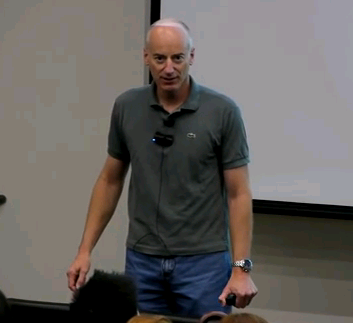UCI Chem 131C Thermodynamics and Chemical Dynamics (Spring 2012)
Lec 10. Thermodynamics and Chemical Dynamics -- Jim Joule --
View the complete course: ../courses/chem_131c_thermodynamics_and_chemical_dynamics.html
Instructor: Reginald Penner, Ph.D.
License: Creative Commons BY-NC-SA
Terms of Use: ../info.
More courses at http://ocw.uci.edu
Description: In Chemistry 131C, students will study how to calculate macroscopic chemical properties of systems. This course will build on the microscopic understanding (Chemical Physics) to reinforce and expand your understanding of the basic thermo-chemistry concepts from General Chemistry (Physical Chemistry.) We then go on to study how chemical reaction rates are measured and calculated from molecular properties. Topics covered include: Energy, entropy, and the thermodynamic potentials; Chemical equilibrium; and Chemical kinetics. This video is part of a 27-lecture undergraduate-level course titled "Thermodynamics and Chemical Dynamics" taught at UC Irvine by Professor Reginald M. Penner.
Thermodynamics and Chemical Dynamics (Chem 131C) is part of OpenChem: ../openchem/
Recorded on April 25, 2012.
Index of Topics:
04:13 - In an adiabatic process, q=0 for the process...
07:51 - note: The change in P with an expansion is larger...
08:04 - Isotherm Graph
10:21 - ...now it's not obvious from these equations...
13:27 - About Jim Joule
14:20 - Joule's dad was a brewer
18:24 - Now, you should know that Joule was quite an experimentalist.
20:09 - Diagram: He actually did this experiment quantitatively
21:04 - The quantity of work that must be expended at sea-level...
22:35 - 77255 and California DMV
22:58 - Diagram: ...so in 1853, he did the following experiment
23:44 - So why did Joule expect a temperature change?
23:49 - ...this is the Leonard-Jones 6-12 potential.
27:29 - For an ideal gas, the intermolecular potential...
27:38 - Diagram: At high pressures, you're here.
28:17 - Diagram: At "normal" pressures, you're here.
28:43 - Well, recall that for a real gas, the compressibility factor...
29:09 - The compressibility factor, Z, for a real gas...
30:29 - The compressibility factor, Z, for a real gas reflects these two manifolds...
31:00 - (Diagram) Now, let's do a thought experiment...
32:33 - question: where does the energy come from?
34:03 - 1853: Jim Joule tried to measure...
35:05 - 1854: Joule teams up with a new friend, William Thompson (AKA Lord Kelvin)
36:40 - The Joule-Thompson Effect...
39:43 - so, the Joule-Thompson process occurs at constant enthalpy.
41:12 - but Joule and Thompson were delighted to find that for real gases...
41:52 - Problem: The Joule-Thompson coefficient of air at 300K and 25 atm...
45:13 - "Plot from your Chapter 14...temperature as a function of pressure."
45:54 - note that real gases have two inversion temperatures at each pressure value:
47:13 - The Linde Refrigerator: A mechanical heat pump...
Required attribution: Penner, Reginald Thermodynamics and Chemical Dynamics 131C (UCI OpenCourseWare: University of California, Irvine), ../courses/chem_131c_thermodynamics_and_chemical_dynamics.html. [Access date]. License: Creative Commons Attribution-ShareAlike 3.0 United States License.


